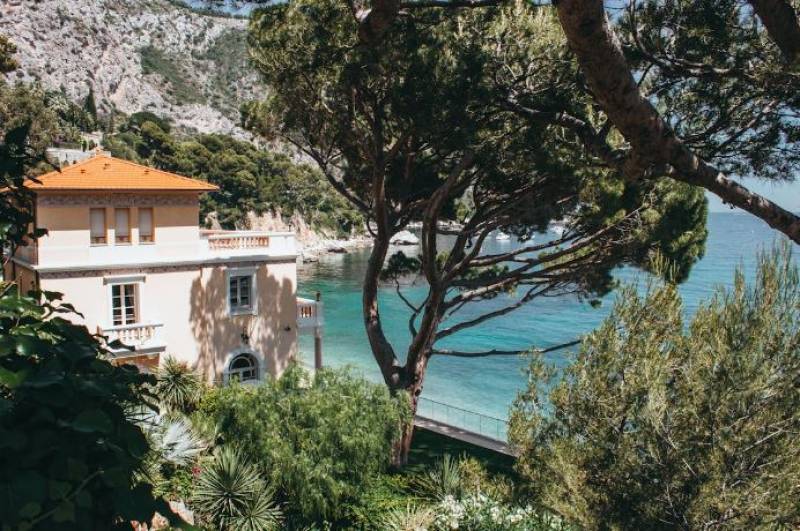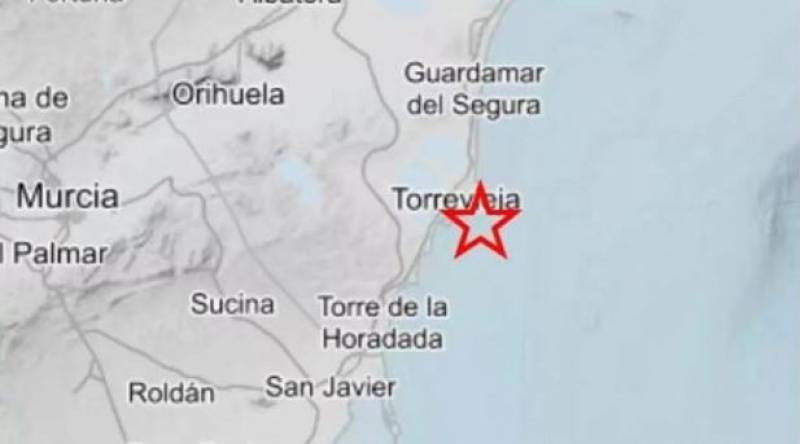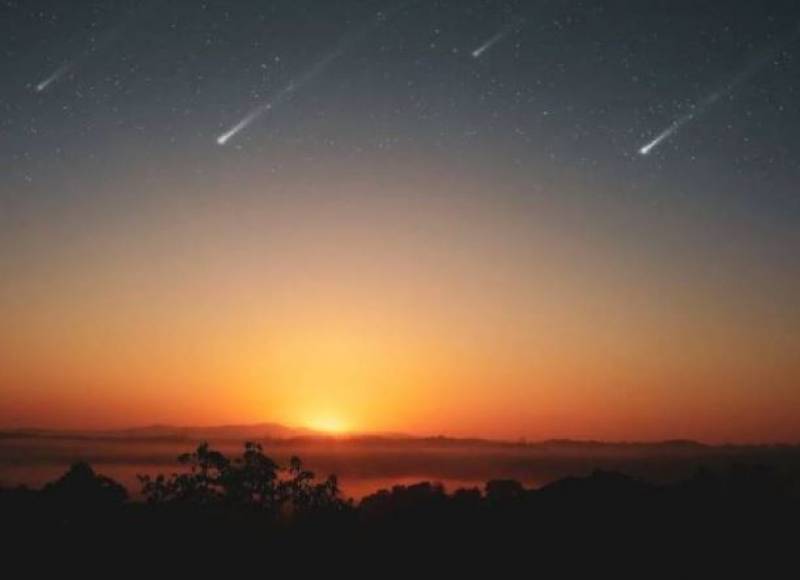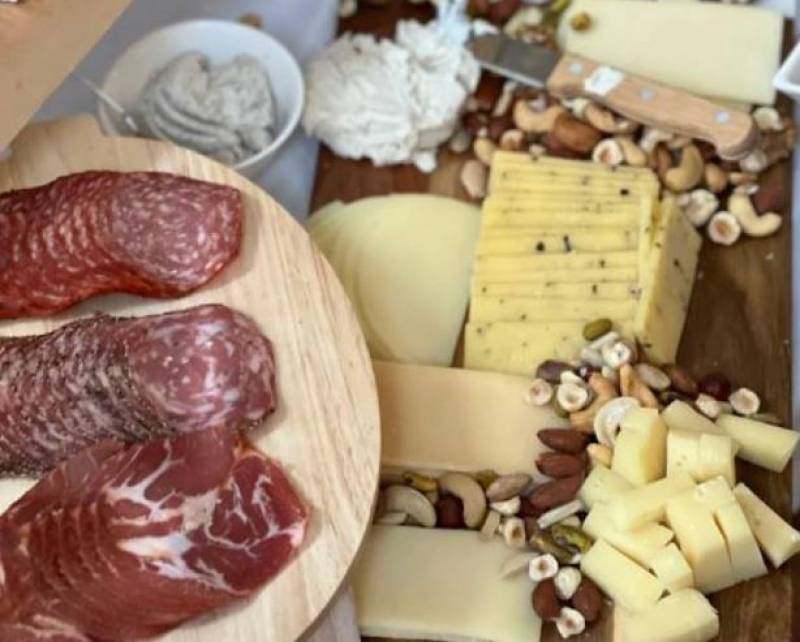Spanish News Today Editors Roundup Weekly Bulletin April 18

TOP STORIES: "UK bans all meat and cheese from the EU" & "English to the south, Germans on the islands: where are foreigners buying houses in Spain?"
Hi there and welcome to this week’s roundup! As we’re in the thick of Easter week, what better time to take a look at some of the wonderfully unique ways it’s celebrated here in Spain – from solemn processions to quirky local traditions.
But if you are on the (not so) sunny Spanish shores this Semana Santa, you might want to think twice about bringing any goodies back home with you, as the UK has just introduced a rather restrictive food ban.
We’re also turning our eyes to the skies for the upcoming Lyrid meteor shower and diving into the latest trends in Spain’s property market.
Without further ado, let’s get into it.
Easter à la España
Holy Week is one of the biggest events in the Spanish calendar, both religiously and culturally. Beginning on Palm Sunday and running through to Easter Sunday, Semana Santa transforms towns and cities into open-air theatres of faith.
What makes it so compelling is the regional variety. No two places do it quite the same, but whether you’re in a small village or a big city, there’s a sense of pride, history and community at its heart.
These garments are called capirotes, and they’ve been worn by penitents in Spain since the Middle Ages. The idea is to express humility and penance while concealing the wearer’s identity. Each brotherhood has its own style, with different colours and symbols that represent their religious group and its history.
So yes, they might look a little strange at first, but they’re part of a centuries-old tradition that’s completely unrelated to anything sinister.
In the Region of Murcia, Semana Santa brings out some truly unforgettable processions. Whether you’re after the theatrical, the traditional or something completely unique,
this part of Spain doesn’t disappoint.
In Cartagena, you’ll find perfectly timed processions that are almost military in their precision. Over in Mula, things get a lot louder. Thousands of drummers fill the streets in a spontaneous and thunderous display of devotion.
Cieza offers a more serene experience with its colourful Palm Sunday procession, while Jumilla blends faith with local wine-making traditions in a way only they could. And in Murcia city itself, floral artistry and baroque religious floats take centre stage.
This year’s processions were back in full force and did not hold back. The White and Blue brotherhoods battled it out in the streets, showcasing elaborately choreographed scenes from the Passion of Christ mixed with Roman pageantry, Egyptian pharaohs and even galloping horses.

If you're used to Easter being all about chocolate eggs and hot cross buns, Spain might surprise you. Here, it’s all about
the torrija – a golden slice of bread soaked in milk or wine, fried until crisp on the outside and melting in the middle, then finished off with a dusting of sugar and cinnamon.
Torrijas have been around for centuries and were originally a clever way to use up stale bread during Lent. But these days, they’re a much-loved Easter treat in their own right.
Honestly, if you haven’t tried one yet, you're missing out.
Above everything, Easter is about spending time with family and friends and for most of us, this revolves around a delicious meal. Whether you’ll be going for the traditional leg of lamb this year or trying your hand at Spanish torrija for the first time, a trip to the supermarkets will probably be in order.
Who’s buying where in Spain?

Spain’s property market is still riding a sunny high, and it's not just locals snapping up homes. Foreign buyers are diving in, turning their holiday dreams into year-round realities, and where they’re buying says a lot about what kind of Spanish life they’re after.
Most aren’t packing up their lives for good, though. For many, it’s about locking in that perfect second home in the sun.
The Germans, meanwhile, have their eyes firmly on the islands. In fact, in the Canary and Balearic Islands, they account for more than half of all foreign property sales. The Brits follow behind, but it’s clear the Germans are making the most of island life.
Up north, it’s all about convenience. French buyers are sticking close to home, picking up properties in Catalonia, Navarra and the Basque Country, just a hop over the border. The Portuguese are making themselves at home in places like Galicia and Extremadura.
According to the latest data from Spain’s notaries, nearly one in five homes sold in 2024 went to a foreign buyer. That’s 139,102 homes in total—a nearly 6% jump from the year before. Most of the action happened in the second half of the year, helped along by falling interest rates from the European Central Bank.
Down in the always-popular Valencian Community, nearly 30% of homes sold in 2024 went to non-Spaniards. Dutch and Belgian buyers are big players there, just behind the British and Germans.
And speaking of Brits, one of them is making waves on TikTok. Jade Gartshore, a young woman from Leicester, has traded in grey skies for sunny streets and is now calling the city of Murcia home.
“Murcia is much better,” she says, and judging by the buzz around her content, plenty of people agree.
She’s in love with the city’s old-world charm, the laid-back lifestyle and the fact that, for now, it still feels like something of a hidden gem.
Sky's the limit
Running from April 16 to 25, the Lyrids put on a subtle but beautiful show, with their peak expected overnight from Sunday April 21 into the early hours of Monday April 22. With the Moon not rising until around 5am, the skies should stay nice and dark, which is perfect for spotting those bright streaks of light as they zip overhead.
While you won’t see a firestorm of meteors like with some of the flashier showers, you can still expect around 15 to 20 meteors per hour in ideal conditions. And every so often, the Lyrids throw in a surprise burst of activity or even a fireball or two.
These shooting stars come from Comet Thatcher, a dusty old traveller that swings by our solar system every 415 years. As Earth passes through its leftover trail of debris, those tiny comet fragments burn up in our atmosphere and give us the show.
For the best view, grab a blanket or a comfy chair, head somewhere dark (away from streetlights), and give your eyes 20 minutes to adjust. No need for fancy equipment, just look up and enjoy the sky doing its thing.
And remember, even though the Lyrids are at their peak on April 22 at around 3.30pm (CEST), your best bet for viewing is still the night before and the early morning hours after.
UK border food ban
Now here’s one bit of news that pretty much slipped in under the radar, but could come as a surprise to a lot of travellers heading back to the UK from Spain after Easter.
The move is part of a push to prevent the spread of foot and mouth disease, which has been reappearing in parts of Europe. While the virus doesn’t pose a risk to humans, it’s highly contagious among livestock and could cause serious damage to UK farming if it were to take hold.
Officials are especially worried about food being thrown away in places where wild animals or farm animals might come across it. Even a small piece of contaminated meat could set off a serious outbreak.
The restrictions apply to any kind of animal-based food, regardless of how it’s packed or where it was bought. Even duty-free items are included. The rules affect people arriving in Great Britain, though they don’t apply to Northern Ireland, Jersey, Guernsey or the Isle of Man.
If banned items are found at the border, they’ll be taken and destroyed. In more serious cases, travellers could face fines of up to £5,000.
The banned list includes all types of meat such as pork, beef, lamb, goat and venison, along with any products made from them like sausages or cured cuts. Dairy products like milk, cheese, butter and yoghurt are also not allowed.
The only exceptions are powdered infant milk, baby food or special medical foods, and even then, there’s a limit of two kilos per person.
With the Easter and summer travel season picking up, holidaymakers are being urged to check the latest import rules before heading to the airport. And if you were planning to pack some Manchego or chorizo for the flight home, it might be better to enjoy them while you’re still in Spain.
Murcia
Residents of Jumilla had a bit of a shaky start to the week. On Monday morning, April 14,
two minor earthquakes hit the area just eight minutes apart. The first measured 3.1 and the second 2.0 on the Richter scale. The National Geographic Institute confirmed the epicentres were just south of town, with one of the quakes occurring right at the surface.
While many residents felt the tremors, there were no reports of injuries or damage, and everything quickly returned to normal. Similar tremors have popped up across the Region in recent months, particularly around Lorca and also in Jumilla back in March.
Despite securing nearly €1.8 million in European funding, the project has been cancelled due to a lack of access to private land. Councillor Diego Ortega explained that property owners refused entry and that the council couldn’t expropriate the land under current urban planning rules.
The council says it remains committed to the Mar Menor’s environmental recovery and will use the technical groundwork already completed for future efforts. Still, critics have called it a major failure, accusing the local government of mishandling what was supposed to be a flagship project.
Finding a parking space in Murcia has become a near-impossible task and for those hoping to invest in one, the figures are eye-watering. With limited supply and growing demand, especially in the city centre, prices have surged, with
some premium spots now selling for up to €80,000.
Renting isn’t cheap either, with prices hovering between €120 and €150 a month in popular areas. What used to be a smart, low-maintenance investment is now mostly reserved for desperate drivers willing to pay whatever it takes to stop circling the block.
Real estate agents say areas like Santa Catalina and San Miguel are the most expensive, while neighbourhoods such as El Carmen or Santa Eulalia offer slightly more affordable options. But be warned: many garages weren’t built with today’s large SUVs in mind.
Public parking lots are also feeling the pressure. Since the city’s Mobility Plan scrapped around 2,000 street-level spaces, the number of pass requests has spiked.
These days, finding a spot feels less like running an errand and more like winning the lottery.
As of midday on Monday, only seven beach bars were officially ready to go, with locations in Cabo de Palos, La Manga, Playa Honda and La Azohía. But many owners say it’s simply too late to open in time for the Easter crowds.
According to officials, 27 beach bars have been awarded concessions out of the 33 available. The new contracts run until 2028, and only those with their paperwork in order and no outstanding debts were considered.
Despite reassurances from the council, bar owners argue the timing has left them entirely on the back foot. One veteran chiringuito manager said that even with the permits in hand, opening this weekend would be impossible.
“Setting up a beach bar is a lot of work,” he summed up.
Looking for something fun to do with the family over the Easter holidays?
The Plaza de los Leones is buzzing with inflatables, archery and giant garden games most afternoons. Murcian crafts workshops offer a hands-on cultural experience, perfect for kids and parents alike.
On April 22, the park will host a special Bando de la Huerta celebration, with festive activities running from morning through mid-afternoon.
Admission during the Spring Festival period is €19 for adults and €15 for children and seniors, and tickets can be purchased both online and at the park entrance.
Set against the backdrop of wild animals and green open spaces, Terra Natura offers the perfect mix of entertainment and education. It’s a great way to spend a day outdoors with the family, with just the right blend of excitement and education.
For more events and activities coming up soon in the Region of Murcia see our EVENTS DIARY.
Spain
It’s all about food this week in Spain! We’ve already learned that the UK has temporarily banned meat and cheese from the EU, but Brussels isn’t resting on its laurels either. Let’s start with your morning coffee, because it might be changing sooner than you think.
Brussels is moving forward with these new environmental regulations that aim to drastically reduce waste in the hospitality industry. Starting next year, businesses across the EU, including cafés, hotels and restaurants, will no longer be allowed to offer single-serve items in disposable containers.
The idea is part of a larger strategy called the Packaging and Packaging Waste Regulation (PPWR), all about cutting back on plastic and pushing towards a more circular economy. Spain, as expected, is all in. The Ministry for Ecological Transition has defined these single-use items as anything made partly or entirely from plastic that’s not intended to be reused.
Think of those free hotel shampoos as collector’s items now.

And speaking of everyday habits getting a health and sustainability makeover,
school lunches are also getting a serious upgrade. This week, Spain passed a new law that puts cafeterias at the heart of a healthier future for kids. Out go the sugary sodas and processed pastries; in come fresh fruit, fish and whole grains.
Every school cafeteria—public, private or subsidised—will now be required to serve five nutritious meals a week, with strict guidelines on what’s allowed on the tray.
It's all part of a national push to tackle childhood obesity and help level the playing field for kids from lower-income families. Studies have shown that nearly half of children in lower-income households are overweight or obese, often due to poor access to fresh foods. So, this new decree isn’t just about cutting out junk—it’s about making sure every child gets a fair shot at a healthy diet.
Menus will now feature daily fruit and veg, with nearly half of it sourced locally and in season. There’s a push for more organic ingredients too. Fish, legumes and whole grains are getting their due, while fried and pre-cooked foods will be strictly limited.
Even school vending machines have been put on notice. If a product has more than 5 grams of sugar per serving, it’s out.
From lunch trays to medicine cabinets, health is clearly on the minds of lawmakers at the minute. The Spanish government also made waves this week by defending
its controversial draft law on medicine pricing. The plan is to drive down costs by encouraging competition between companies making generic and biosimilar drugs, especially for medications that have lost patent protection but still carry hefty price tags.
Not everyone’s thrilled and some in the pharmaceutical industry worry the changes could make certain drugs unprofitable and harder to find, while doctors and pharmacists have raised concerns about patient safety and professional oversight.
But the Health Ministry is standing firm. Secretary of State for Health Javier Padilla says the reform isn’t an auction system, but rather a push for balance—cheaper meds, without compromising care.
Interestingly, one of the more talked-about parts of the bill has nothing to do with prices. Nurses and physiotherapists could soon gain the power to prescribe certain medications independently. Nurses say this better reflects what they’re already doing and brings their legal responsibilities in line with their training.
Doctors are a bit more cautious, but the ministry insists the change is practical, overdue and ultimately safer for patients.
Alicante

The tremor struck just after midnight and, while officially considered minor, its shallow depth—only two kilometres—meant it was widely felt in towns across the region.
The epicentre was located offshore near Torrevieja, but the vibrations reached as far inland as San Fulgencio, Rojales and San Miguel de Salinas. The National Geographic Institute was inundated with calls from concerned residents, particularly with the area buzzing with Easter tourists.
On the European macroseismic scale, the quake registered between levels II and IV—enough to rattle dishes and shake light fixtures, though thankfully not enough to cause any damage.
It’s not the first time the corner of southern Spain has been shaken. This part of Alicante, particularly the Vega Baja, is one of the most seismically active zones in the country, second only to Granada. Dozens of micro-earthquakes occur here each year, and while most go unnoticed, those over magnitude 2 often make their presence known.
Building regulations in the area have included seismic risk considerations since the early 2000s, a precaution rooted in a long history of powerful quakes—most notably the devastating seismic swarm of 1829, which levelled parts of Torrevieja and surrounding towns, leaving hundreds dead.
Today, places like Almoradí still commemorate the disaster, with a newly opened museum dedicated to the region’s seismic past.
Flames quickly engulfed four apartments—two on the second floor where the fire started, and two directly above—though, remarkably, no serious injuries were reported.
Emergency crews from the Alicante Provincial Fire Consortium responded rapidly, with units from both Torrevieja and Orihuela stations on the scene.
One resident was treated for an anxiety attack and thanks to the quick response, firefighters managed to prevent the fire from spreading further throughout the building.
Still, the incident has renewed focus on the safety and infrastructure needs of the area, needs that residents say have long gone ignored.
In that vein, there may finally be some progress on another long-awaited project in Orihuela Costa. After years of delays and calls for action, the city council has officially opened the tender process for
a pedestrian footbridge and cycle path over the AP-7 motorway. The bridge would connect the inland neighbourhoods with the coastal area via Lomas de Cabo Roig, a busy crossing point that has seen far too many accidents and close calls.
The contract, which covers the drafting of the design project, comes with a €86,300 budget and a four-month timeline. Once completed, the final step will be to tender the actual construction works, which are expected to cost around €1.3 million.
The planned walkway will feature a mixed-use path for pedestrians and cyclists, with separate lanes wide enough to ensure safety for both. LED lighting is also included in the design, along with connections to existing road infrastructure via Calle Creus and San Miguel Road.
After so many years of waiting, officials say this is a significant step toward delivering a much-needed solution for the coastal community.
However, local residents are more reticent, taking the ‘we’ll believe it when we see it’ approach.
Andalucía
The procedure, which took place at a property on Avenida Cortijos de Marín, led to severe haemorrhaging. Despite the parents rushing the infant to a local health centre on Calle Maximiliano at around 9pm, doctors were unable to save the child’s life.
Investigators say the parents, of Malian origin, had paid €100 for the procedure, unaware of the potentially fatal consequences. The Guardia Civil quickly arrested both the parents and the man who performed the circumcision. According to the High Court of Justice of Andalucía, the individual lacked medical qualifications and carried out the operation “without the necessary hygiene measures.” He has since been remanded in custody without bail.
While the parents have been provisionally released, they are barred from leaving the country and remain under investigation for alleged reckless homicide.
Mr Barr, 37, had vanished on Sunday January 28 while visiting the Costa del Sol town with friends and family. A few days after his disappearance, some of his belongings, including trousers and a passport, were found near a beach, sparking an intense and emotional search.
Unbeknownst to his family at the time, a body had washed ashore on March 3. It wasn’t until early April, after DNA testing, that it was confirmed to be Mr Barr.
Mr Barr’s death has been ruled a drowning, but further details are still pending.
The pop icon will perform first at the Nuevo Mirandilla Stadium in Cádiz on Wednesday July 10 and then hit the stage at the Málaga City Athletics Stadium the very next night, Thursday July 11.
Tickets go on sale Wednesday April 16, at noon, and demand is already sky-high.
In Cádiz, prices range from €60 to €375, depending on seating options, with premium Front Stage Early Entry tickets at the top end. Málaga’s prices start at €130 for general track access, with similar VIP packages also reaching €375.
For superfans, there’s an ultra-exclusive opportunity to snap a photo with J.Lo herself for a whopping €1,700. It’s worth noting, though, that this only includes the photo opportunity, not entry to the show.
The Up All Night tour is expected to feature a mix of Lopez’s biggest hits along with new material, all delivered with her signature mix of pop, R&B and Latin flair. After six years away from Spanish stages, she’s making a serious comeback and with her legendary stage presence, it promises to be a spectacular night.
Tickets can be purchased through Enterticket and while Santander customers enjoyed an exclusive pre-sale until April 15, the general public now has full access. Whether you’re a lifelong fan or just looking for a summer night to remember, this is one show not to miss.

You may have missed…
- Spanish beaches introduce pay and display sunbeds.
Tourists heading to some of Gran Canaria’s most popular beaches this summer will notice a new addition to the sand: pay-and-display machines for sunbeds and parasols.
- Alicante inundated with more campervans than ever this Easter.
According to the Valencian Caravanning Association, the region is expecting a record-breaking influx of more than 4,500 motorhomes before the week is out, marking a 12% increase from last year’s figures.
- Last-minute Easter bookings fill Murcia hotels almost to capacity.
There’s no two ways about it – the Region of Murcia does Easter very, very well, so it’s no surprise that thousands of tourists from all over the world jet off to this corner of southern Spain to enjoy the Semana Santa celebrations. And 2025 is absolutely no exception, with virtually every hotel and bed in the Region booked solid.
- Scientists use whale cams to prevent orca boat attacks in Gibraltar.
To better understand the fascination orcas seem to have with boats and in an effort to prevent more accidents in the future, marine researchers in Gibraltar are turning to cutting-edge technology, which includes tiny, animal-mounted cameras.
- Murcia sets its sights on the UK, Canada and Mexico in the wake of Trump tariffs.
As fears grow that businesses will suffer severe losses thanks to Trump’s aggressive policies, this group of experts has pinpointed a number of promising alternative markets across China, Mexico, East Africa and Europe.
And that’s that for another week. Have a fantastic Easter everyone and we'll see you next week!
Bye bye!


 Spanish News Today
Spanish News Today
 Alicante Today
Alicante Today
 Andalucia Today
Andalucia Today


 If you're used to Easter being all about chocolate eggs and hot cross buns, Spain might surprise you. Here, it’s all about the torrija – a golden slice of bread soaked in milk or wine, fried until crisp on the outside and melting in the middle, then finished off with a dusting of sugar and cinnamon.
If you're used to Easter being all about chocolate eggs and hot cross buns, Spain might surprise you. Here, it’s all about the torrija – a golden slice of bread soaked in milk or wine, fried until crisp on the outside and melting in the middle, then finished off with a dusting of sugar and cinnamon.


 A major environmental project in the Mar Menor area has unfortunately been shelved as Cartagena City Council has decided against installing a new rainwater drainage system for Mar de Cristal, Islas Menores and Los Nietos. The goal was to improve runoff management and complement ongoing work in the Carrasquilla ravine.
A major environmental project in the Mar Menor area has unfortunately been shelved as Cartagena City Council has decided against installing a new rainwater drainage system for Mar de Cristal, Islas Menores and Los Nietos. The goal was to improve runoff management and complement ongoing work in the Carrasquilla ravine.
 And speaking of everyday habits getting a health and sustainability makeover, school lunches are also getting a serious upgrade. This week, Spain passed a new law that puts cafeterias at the heart of a healthier future for kids. Out go the sugary sodas and processed pastries; in come fresh fruit, fish and whole grains.
And speaking of everyday habits getting a health and sustainability makeover, school lunches are also getting a serious upgrade. This week, Spain passed a new law that puts cafeterias at the heart of a healthier future for kids. Out go the sugary sodas and processed pastries; in come fresh fruit, fish and whole grains.


















